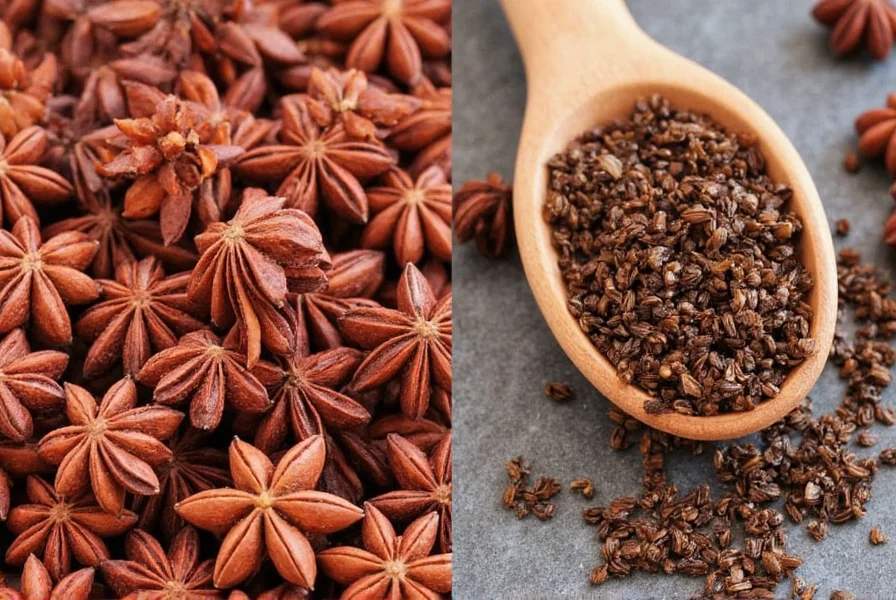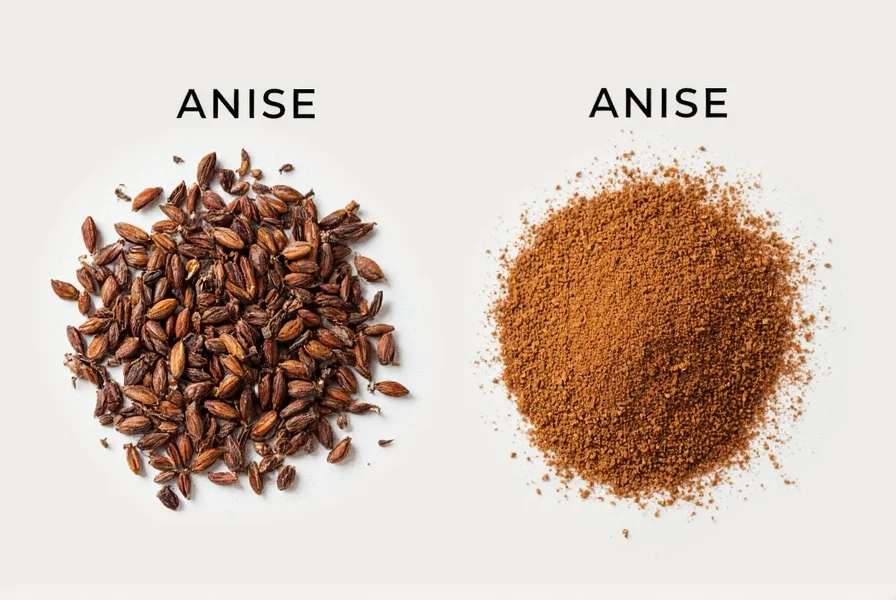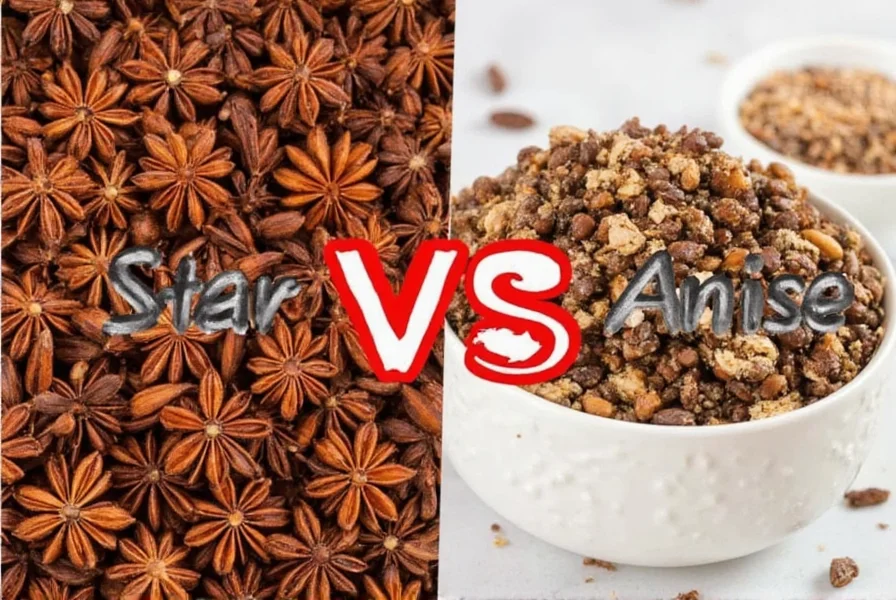When exploring the world of aromatic spices, few comparisons generate as much confusion as star anise versus anise. Both deliver that distinctive licorice-like flavor profile, but understanding their fundamental differences is crucial for culinary success and safety. This comprehensive comparison examines their botanical origins, flavor chemistry, culinary applications, and practical substitution guidelines.
Botanical Origins and Physical Characteristics
Star anise grows on Illicium verum, an evergreen tree reaching 20-50 feet in height, primarily cultivated in southern China and Vietnam. The spice consists of the immature fruit, which forms a distinctive 6-8 pointed star shape measuring 1-2 inches across. Each point contains a single seed, but the entire star structure is used as the spice.
Anise, by contrast, comes from Pimpinella anisum, an annual herb in the Apiaceae family (same as parsley and carrots) that grows to about 2-3 feet tall. The spice consists solely of the small, grayish-brown oval seeds measuring approximately 1/8 inch long. These seeds develop in伞-shaped clusters after the plant flowers.
| Characteristic | Star Anise | Anise Seed |
|---|---|---|
| Botanical Name | Illicium verum | Pimpinella anisum |
| Plant Type | Evergreen tree | Annual herb |
| Part Used | Whole immature fruit | Seeds only |
| Shape | 8-pointed star (1-2" diameter) | Oval seed (1/8" long) |
| Primary Growing Regions | China, Vietnam | Mediterranean, Middle East |
Flavor Chemistry and Taste Profile
Both spices contain anethole, the compound responsible for their characteristic licorice flavor, but in different concentrations and with additional compounds that create subtle distinctions. Star anise contains approximately 90% trans-anethole, while anise seed contains 80-90% anethole along with other compounds like estragole and limonene.
The flavor difference becomes apparent when tasting them side by side. Star anise delivers a more intense, sharper licorice note with subtle hints of cinnamon and clove. Anise seed offers a sweeter, milder licorice flavor with delicate floral undertones. When used in cooking, star anise tends to impart its flavor more quickly and powerfully than anise seed, which requires longer cooking times to fully release its aroma.
Culinary Applications and Pairing Suggestions
Star anise shines in slow-cooked dishes where its robust flavor can permeate throughout. It's essential in Chinese five-spice powder, Vietnamese pho broth, Indian garam masala, and many Middle Eastern meat dishes. Chefs often add whole stars to braises, stews, and poaching liquids, removing them before serving. It pairs exceptionally well with citrus, ginger, cinnamon, and black pepper.
Anise seed works best in baked goods, desserts, and lighter applications where a more delicate licorice note is desired. It's traditional in biscotti, rye bread, fruit compotes, and Middle Eastern spice blends like baharat. Ground anise seed enhances cookies, cakes, and fruit-based desserts. It complements fennel, coriander, and citrus flavors beautifully.
Medicinal Properties and Safety Considerations
Both spices have been used in traditional medicine systems for centuries. Star anise contains shikimic acid, a key ingredient in the antiviral medication oseltamivir (Tamiflu). It's traditionally used to aid digestion, relieve coughs, and as a mild antimicrobial agent. However, Japanese star anise (Illicium anisatum) is toxic and should never be consumed—always ensure you're using Chinese star anise.
Anise seed has been studied for its potential digestive benefits, including relief from bloating and gas. It contains compounds with mild estrogenic effects and has been traditionally used to support lactation in nursing mothers. Both spices should be used in culinary amounts, as excessive consumption may cause adverse reactions in sensitive individuals.
Substitution Guidelines for Home Cooks
When substituting between these spices, understanding their potency differences is crucial for star anise versus anise seed replacement. As a general rule:
- 1 whole star anise ≈ 1/2 teaspoon ground star anise ≈ 3/4 teaspoon anise seed
- For ground substitutions: 1/4 teaspoon ground star anise ≈ 3/8 teaspoon ground anise seed
When substituting star anise for anise seed in baking, use approximately 25-30% less star anise to prevent overpowering the dish. For savory applications like pho or braises, star anise can typically replace anise seed in equal measure. Always add star anise early in the cooking process to allow its flavor to fully develop, while anise seed benefits from being added slightly later.
Storage Recommendations for Maximum Freshness
Proper storage significantly impacts the shelf life and flavor intensity of both spices. Store whole star anise in an airtight container away from light and heat, where it will maintain peak quality for 2-3 years. Ground star anise loses potency more quickly and should be used within 6-12 months.
Anise seeds retain their flavor best when stored whole. Keep them in a cool, dark place in an airtight container for up to 2 years. Ground anise seed should be used within 3-6 months for optimal flavor. To test freshness, crush a small amount between your fingers—if the aroma is weak or musty, it's time to replace your supply.
Common Misconceptions Clarified
Many people assume star anise and anise seed are interchangeable without adjustment, but their different chemical compositions mean they interact uniquely with other ingredients. Another common misconception is that all star-shaped spices are the same—Japanese star anise is dangerously toxic and should never be used culinarily.
Understanding the difference between star anise and anise seed helps prevent culinary mistakes and ensures you're using the appropriate spice for your recipe. While they share a similar flavor profile, recognizing their distinct characteristics allows for more precise seasoning and better dish outcomes.

Frequently Asked Questions
Can I use star anise instead of anise seed in baking?
Yes, but with caution. Star anise has a stronger, more intense flavor than anise seed. When substituting in baking recipes, use approximately 25-30% less star anise than the recipe calls for in anise seed. For best results, grind the star anise to match the texture of ground anise seed, or steep whole stars in warm liquids before incorporating into your batter.
Is Chinese star anise safe to consume regularly?
Chinese star anise (Illicium verum) is generally recognized as safe when used in culinary amounts. However, Japanese star anise (Illicium anisatum) is toxic and should never be consumed. Always purchase from reputable spice merchants to ensure you're getting the safe variety. Consuming large quantities of Chinese star anise regularly may cause neurological symptoms in sensitive individuals, so moderation is advised.
What's the best way to grind star anise for recipes calling for ground anise?
The most effective method for grinding star anise is to first toast the whole stars in a dry skillet over medium heat for 1-2 minutes until fragrant, then cool completely. Use a dedicated spice grinder or mortar and pestle to achieve a fine powder. For recipes calling for ground anise seed, substitute 3/4 teaspoon ground star anise for every 1 teaspoon of ground anise seed required.
Why does my star anise taste bitter?
Bitterness in star anise typically results from over-extraction or using old, degraded spice. Star anise should be added early in the cooking process but removed after 20-30 minutes in liquid-based dishes to prevent bitterness. If using in dry applications like spice rubs, ensure your star anise is fresh (within 1-2 years of purchase). Old or improperly stored star anise loses its sweet notes and develops bitter compounds.
Can I grow my own anise or star anise plants?
Anise seed plants (Pimpinella anisum) can be grown in home gardens in USDA zones 4-9, requiring full sun and well-drained soil. They grow as annuals, reaching 2-3 feet tall. Star anise trees (Illicium verum) are much more challenging, requiring tropical conditions (USDA zones 10-11), high humidity, and partial shade. They take 6-7 years to produce fruit and grow 20-50 feet tall, making them impractical for most home gardeners outside their native Southeast Asia.












 浙公网安备
33010002000092号
浙公网安备
33010002000092号 浙B2-20120091-4
浙B2-20120091-4